Lao PDR Diary: Vientiane to Savannakhet
Lao PDR's Vientiane is quite a contrast from what is typical of the larger cities in Southeast Asia. When compared to Phnom Penh's streams of motorbikes and Bangkok's sprawling industrial largess, it is as though Vientiane is continually drifting off to sleep.
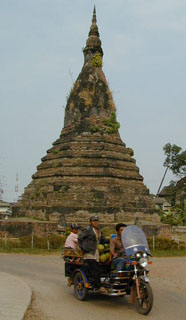 Groups of monks shuffle along the streets, their orange robes standing out against the backdrop of many foreign-friendly restaurants, souvenir shops, and Internet cafes. On street corners, women sell handmade sandwiches from carts. Taxi drivers gather on their three-wheeled vehicles (painted in beach scenes and western product logos) and talk in front of the small hotels and guesthouses waiting for fares. At around 8AM there is a bit of a rush hour consisting of taxis, bicycles, and motorbikes. But pausing for a cup of Cafe Lao at a coffee shop might cause one to miss it. And this is for Vientiane - the capital city.
Groups of monks shuffle along the streets, their orange robes standing out against the backdrop of many foreign-friendly restaurants, souvenir shops, and Internet cafes. On street corners, women sell handmade sandwiches from carts. Taxi drivers gather on their three-wheeled vehicles (painted in beach scenes and western product logos) and talk in front of the small hotels and guesthouses waiting for fares. At around 8AM there is a bit of a rush hour consisting of taxis, bicycles, and motorbikes. But pausing for a cup of Cafe Lao at a coffee shop might cause one to miss it. And this is for Vientiane - the capital city.
Highway 13 is the road from Vientiane to Savannakhet. My driver for the 6-hour journey is from a province in the north part of Lao PDR. He is 31.
"PDR" is People's Democratic Republic, or meaning it is a communist country. Lao PDR was officially proclaimed in December 1975. This ended 600 years of rule by the Lao monarchy and was the result of communist forces claiming victory at the conclusion of a civil war that spanned 20 years.
This then is another unique wrinkle. Flags with the hammer and sickle are around to a small extent. So are billboards showing some of the things in the way of public works and education that the government is doing for the people. For the visitor these are far more interesting than in any way intimidating. But for a Laotian, things are slightly different. As we pass Wat Simuong (the colorfully decorated pagoda in which women pay their respects just before they are due to give birth) on our way out of Vientiane, my driver explains:
There is one political party - the Lao People's Revolutionary Party (LPRP). We have to follow their rules, their orders. Not many people have the right to say anything against their policies. If you are a high-ranking officer in the LPRP, you have to be careful with what you say. Some members might have differing opinions. These people have disappeared, I heard.
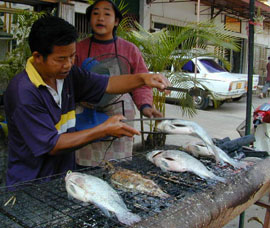 Aside from some sections that weave through small green hills, the single lane road (of surprisingly well-maintained asphalt) travels mainly the lowland areas of the Mekong River. As a result, erosion has left much of the countryside covered in a layer of red dust. Shop fronts, roofs of shacks, and inactive cars are all dusted with a fine red powder.
Aside from some sections that weave through small green hills, the single lane road (of surprisingly well-maintained asphalt) travels mainly the lowland areas of the Mekong River. As a result, erosion has left much of the countryside covered in a layer of red dust. Shop fronts, roofs of shacks, and inactive cars are all dusted with a fine red powder.
If you have a friend or relative in business here, it is very easy to get work done. If not, it is very difficult. For this reason I find it hard. For example, I have to renew the tax certificate for our company. It should take 1 or 2 weeks. But unless money is given under the table it will not be processed in this time. The workers receive a low salary so $50 will be enough to get it processed in a reasonable in the time it should.
The road is full of small stories for which I can only see small parts.
Two soldiers riding elephants pass us going in the other direction. Large and thick chains swing from around the elephants' necks.
The female proprietor of a small restaurant throws water from a silver bowl onto the ground outside her shop. Chickens scatter.
A man of perhaps 80 walks to the edge of the road. He is hunched over in what seems to be a permanent bend. My driver taps the horn three times. On this road (and all in Lao), the horn is almost as vital as the break pedal.
I used to work for an import/export company. We used to import asphalt across the Friendship Bridge from Thailand to Vientiane. Invariably, the customs officer would ask for more money under the table to process the documents quickly. If I don't pay, then the asphalt waits in the warehouse.
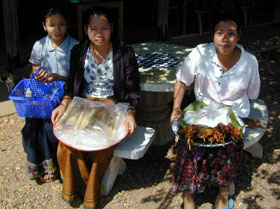 After crossing the Nam Ngum River at a point before it empties into the Mekong, we stop at the side of the road for noodles. Three girls are selling handmade foods: kaolam (sticky rice and coconut stuffed in bamboo and grilled), pinkgai (grilled chicken), gatan (a small fruit), and tourin (peanuts).
After crossing the Nam Ngum River at a point before it empties into the Mekong, we stop at the side of the road for noodles. Three girls are selling handmade foods: kaolam (sticky rice and coconut stuffed in bamboo and grilled), pinkgai (grilled chicken), gatan (a small fruit), and tourin (peanuts).
I buy two pieces of kaolam for 5,000 kip (50 cents). She smiles.
Before 1975 our leader was King Savang Vatthana. Then he abdicated after the communist victory. For eight years my father was in a prison camp in Hua Phan Province. He was fighting against the communists in the civil war. During this time, many soldiers and civilians would swim across the Mekong to Thailand to escape the war. Some had boats. The communist soldiers would shoot at them. When they would arrive there they had to pay to get into the refugee camp. Some women were raped and some men were killed by the Thai soldiers. The lucky ones managed to escape to Australia and the US.
The road passes through some small villages but also some large towns. Most are farming communities. Their homes are usually small thatch-covered shacks. But the ornate architecture of others offers hints of Lao's former French colonial past.
A few months ago, a bomb was detonated in the post office in Vientiane. It was inside a parcel. There was only one injury. This was in the domestic terminal. Another bomb was found in the international terminal before it detonated. Then on the Friendship Bridge, a bomb exploded in the customs office around the same time. Ten people were injured and taken to a Thai hospital. At the Morning Market, Vientiane's central market, a blast injured six people. I think the responsible group is one that is against the LPRP and supports the former monarchy.
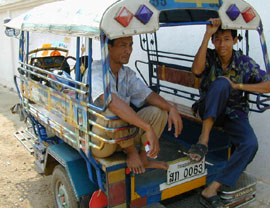 Our car is a red air-conditioned 4-door Kia sedan. It was made in a factory in Savannakhet and cost $13,000. It is one of the nicer vehicles on the road as most of the rest are old, large, and overcrowded trucks and buses.
Our car is a red air-conditioned 4-door Kia sedan. It was made in a factory in Savannakhet and cost $13,000. It is one of the nicer vehicles on the road as most of the rest are old, large, and overcrowded trucks and buses.
There is still some other random violence today. I don't dare go to Xieng Khuang Province because of the bandits. On the road to Luang Prabang up north, ten years ago buses were stopped, shot, and robbed. These are more people that are against the current government and favor the old monarchy. But this area has been getting much better lately. In fact, in the 1980s, security on this road, was not good. It was common for cars to be shot and burned. Today it is fine.
Farm activity is the norm. Many farmers ride on the right side of the road with tractors pulling carts loaded with various equipment. Livestock and farm animals are everywhere.
One kilometer of road might go like this (with at least one tap of the horn for each animal encounter):
Pig on right. Two ducks on right. Chicken on left. We come up behind a truck. A boy sits on the back end. He is asleep. His feet dangle precariously over the truck's bed. About a dozen other family members are packed inside. The truck's sides are of high wood and lashed to its roof is a large amount of bags and supplies. We change lanes into oncoming traffic and accelerate ahead of the truck. I hope the boy does not wake. We change lanes in front of the truck and just before collision with a bus approaching in the other direction. Four cows on right. We slow down to allow duck and ducklings to cross. Pig on left. Farmer hauling hay on right. Bicyclist on right. Chicken. Dog. Duck...
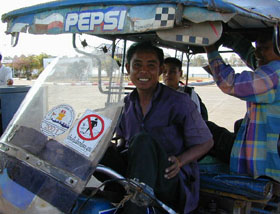 Three months ago, a guy from England came to Lao as a tourist. He fell in love with a Lao girl. She owns a small restaurant. He wanted to get married. Initially, he was staying at a guesthouse but he soon moved into her house. Then he was arrested because it is illegal for a couple to live together before marriage. My mother knows the father of the girl. My mother asked a relative in the army for help. Through negotiations, he had to pay $1,200. He had to leave the country. But now he is preparing the marriage documents.
Three months ago, a guy from England came to Lao as a tourist. He fell in love with a Lao girl. She owns a small restaurant. He wanted to get married. Initially, he was staying at a guesthouse but he soon moved into her house. Then he was arrested because it is illegal for a couple to live together before marriage. My mother knows the father of the girl. My mother asked a relative in the army for help. Through negotiations, he had to pay $1,200. He had to leave the country. But now he is preparing the marriage documents.
After arriving in Savannakhet, we enter the Souda Savan Restaurant I to try a meal of sindad. My driver said that this is very popular with young people these days.
All the tables have a depression in the center. The waitress brings out a bucket of coals and sets it inside. An aluminum cover - in the shape of a derby hat - is set on top. Dishes of vegetables and meat are then brought by the waitress. After spreading a layer of fat over the hot silver dome, the meat is grilled on top. There is a trough - or the brim of the hat - around the edge that collects a nice broth. The vegetables are mixed inside. The broth is ladled into bowls like soup. The process is not too dissimilar from Japanese yakiniku.
The waitress brings out another round of Beerlao. I point at the diamond Chevy Camaro logo patch on her shirt. I ask her, through my driver's translation, if she knows what it means.
"It's the flag of a country," she says.

